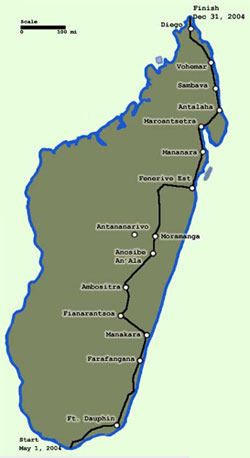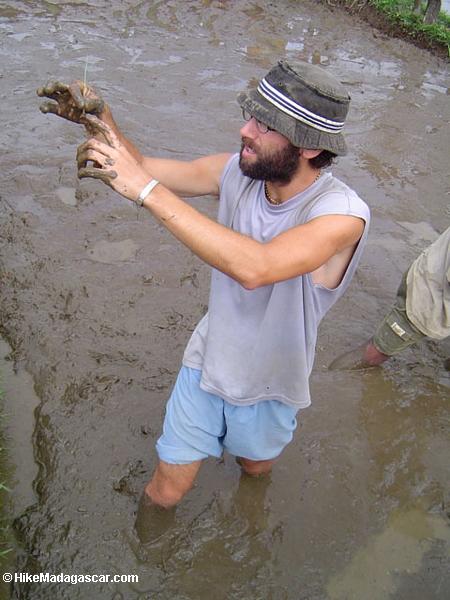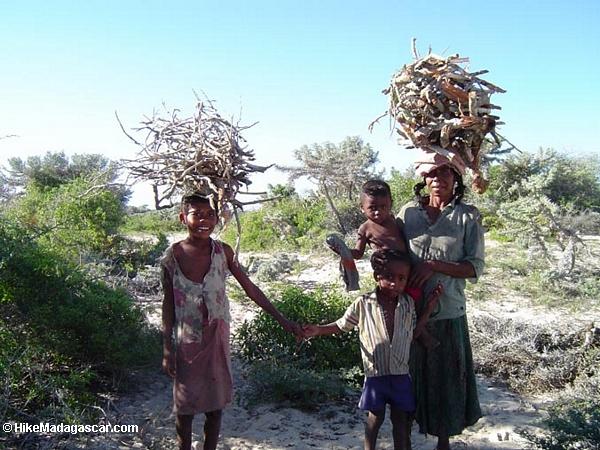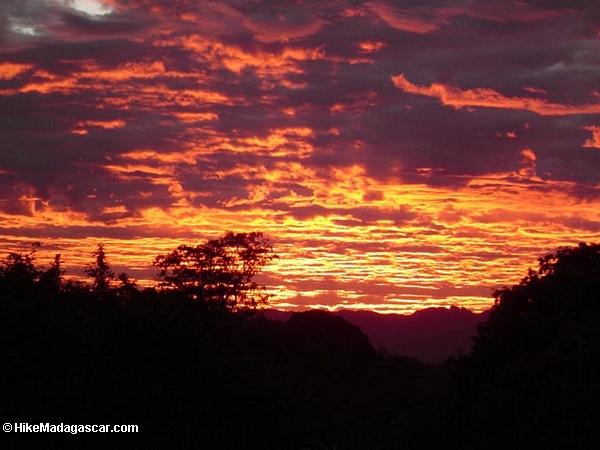Group completes first megatransect of Madagascar
Rhett A. Butler, wildmadagascar.org
September 27, 2005

Sorensen looking at the road ahead in Madagascar
 |
Late last year an international team completed the first known transect of the island of Madagascar, the world’s fourth largest island. The eight-month-long journey, dubbed “Hike Madagascar,” took the group of intrepid hikers from the southern tip of Madagascar to the northernmost point of the island. The transect targeted rural communities along the eastern forest corridor, surveying villages and providing local farmers with techniques for improving rice yields and putting more food on the table for their families. The hike also provided a glimpse into some of the socioeconomic and environmental issues facing the island nation, which is one of the poorest in the world.
Madagascar, a place like no other
Madagascar, an island slightly larger than the state of California, has some of the best wildlife on the planet. Isolated in the Indian Ocean off the coast of southern Africa, about 80% of its native flora and fauna are unique to the island. The island is home to such evolutionary oddities as lemurs, a group of primates endemic to the island; brilliantly colored lizards including geckos and chameleons; tenrecs, spiny hedgehog-like creatures; and the fossa, a carnivorous animal that looks like a cross between a puma and a dog but is closely related to the mongoose. Madagascar has baobab trees, which look like they’ve been planted upside down; the rosy periwinkle, a delicate flower used to cure pediatric leukemia and Hogkin’s disease; and an entire desert ecosystem consisting of just spiny plants.
 |
While Madagascar is best known for its flora and fauna, it is also a land of extraordinary cultural richness and remarkable history. It’s a place where ancestors are as much a part of the present day as they are of the past; where in many areas taboo and tradition take precedence over the law; and western-style religion is freely mixed with beliefs in sorcery and unparalleled funerary customs. The residents of Madagascar, the Malagasy, speak a language native to Borneo (across the Indian Ocean in Indonesia) and observe some distinctly southeast Asian religious practices; use Arabic-rooted words for months and days of the week; and greatly treasure African Zebu cattle. Given Madagascar’s proximity to the African coast who would have expected such a background? Who would have thought that 2000 years ago the island’s first settlers had origins in Indonesia?
As the island’s unique ecosystems increasingly give way to subsistence farming and cattle grazing, there is a new sense of urgency to document the island and work to conserve what remains. In recent years conservation biologists, biogeographers, anthropologists, and archeologists have flocked to Madagascar but there is still a great deal to learn, especially in how local Malagasy interact with their environment. With this in mind, a team set out in 2004 to complete the first transect of Madagascar.
The Hike Madagascar Transect
The transect was led by Meredith Sorensen and Josh Poole, two former Peace Corps workers fluent in Malagasy language and culture, who well-versed in both long-distance hiking and offering advice to rice farmers.
 |
“Josh and I were uniquely qualified to take on the challenge of walking the length of Madagascar while working with farmers along the way,” says Meredith Sorensen, co-leader of the expedition. “We had both independently hiked the entire Appalachian Trail, a 2,168 mile footpath along the Appalachian Mountains in the eastern United States, and we were experienced rice technicians. We combined our long-distance hiking skills with our passion for outreach education projects and created Hike Madagascar.”
Over the course of the trip, Sorensen hiked some 3600 kilometers, delivered 74 presentations on improved agricultural techniques, composting, and family planning, and promoted healthier communities that better manage their resources. Poole helped design the hike, and lead the first half of the journey.
The Hike Madagascar team included three other members: Hal Jackson, Nol Rakotondrabe, and J. Rhett Jackson. Hal completed the southern half of the hike, performed countless informal skits with his puppet, mandolin, and juggling sticks, and built two yurts as examples of alternative housing. Nol, a 14-year-old boy from Madagascar, joined the southern half of the expedition for six weeks and facilitated cultural exchanges, cooked many meals, and was a constant source of comic relief. J. Rhett Jackson (no relation to Hal Jackson), webmaster and videographer for the hike, completed six weeks of the endeavor in the northern half of the island and took footage of the adventure. Numerous friends, families, organizations, and officials also made the hike possible with their sponsorships and support, while ANGAP, The North Face, Air Madagascar, GoLite, Madacom, and were among the corporate sponsors for the Hike Madagascar project.
Improving Rice Farming Techniques
The Hike Madagascar team set out to help rural Malagasy improve their agricultural techniques. Since rice is the backbone of Malagasy diet, culture, and economy, this meant the group primarily offered tips with rice cultivation.
 |
“Rice is the staple of the Malagasy diet. Most people in Madagascar eat rice three times a day and some Malagasy will say that they do not feel full from a meal unless there is a portion of rice,” explains Sorensen. “King Andrianampoinimerina, who ruled the island from 1797-1810, once declared ‘Rice and I are one’ showing the importance of rice extends well beyond its nutritional value in Malagasy culture.”
While Madagascar once grew enough rice to feed itself, traditional cultivation techniques in the presence of a fast-growing population has resulted in soil degradation and erosion that has diminished the country’s agricultural capacity. Thus today, Madagascar relies on imports from other countries to feed its population.
In an effort to address the problems of declining yields and diminished land productivity, the Hike Madagascar team offered its expertise in rice farming techniques.
“Their traditional farming cycle entails slashing and burning untilled land, growing rice on it for a few seasons, then moving on to clear more fertile land for the rice while planting corn or manioc in the nutrient-stripped soil. This rotation leads to a vast, rolling succession of deforestation,” says Sorensen. “Most farmers were eager to learn how to improve the yields in their rice fields. I was excited to provide an alternative to their land-intensive method of continual migration. Both Josh and I taught motivated farmers SRI, a system of rice intensification.” Essentially, SRI’s key principles are to
- use compost
- plant the seedlings early
- plant one seedling at a time
- give each seedling at least 25cm of space
- weed the field early and often
- control the water level of the field
“Each principle the farmer adopts increases his yields exponentially. SRI allows farmers to increase their crop production on less land while improving the soil fertility with each harvest.” The SRI technique is described in further detail in a pdf document from Cornell [English | Spanish].
At Pace With the People
 |
On foot the entire way, the Hike Madagascar effort was unique in that they matched their pace and presentations with the needs of the people along the way. For example, farmers in the dry, harsh, desert-like south had different interests than farmers in the lush, tropical northeast of the country.
“Some farmers wanted to know more about natural insecticides while others were curious about spacing their rice plants, but, whatever the topic,” notes Sorensen, “we offered suggestions on how they could improve their technique using locally available resources. As a follow-up, we often gave farmers an agricultural pamphlet to use as a reference when we were gone.”
Sorensen and Poole, both fluent in the language of Madagascar, Malagasy, either delivered presentations to large groups in town squares or small gatherings in village courtyards. Sometimes they literally jumped into people’s fields and gave a hands-on demonstration. No audience was too big, too small, or too out-of-the-way for Hike Madagascar.
 |
“While our work — teaching agricultural techniques — was helpful for the farmers, I often thought that our play — singing songs, smiling, talking with people, playing with people — was even more beneficial in a broader sense of Madagascar’s collective learning and development,” says Sorensen. “Some people were wary of us when we walked into their village. After a talk, a song, a game, or at least a laugh, we left villages with crowds full of smiles. I believe the people we met will be that much more inclined to interact with, perhaps learn from, the next stranger that crosses their path.”
“Everyone gained something from our walk,” Sorensen continues. “Children practiced their English with us on their way to school. Women walking to the market asked questions about our backpacks, curious if we ever carried them on our heads. Mothers talked with me about their children, and marveled that I was waiting so long to bear my own. I pointedly asked young girls what their dreams and aspirations were in life. Step by step, we touched peoples’ lives.”
Madagascar Committed to Change
Hike Madagascar’s efforts were in step with key reforms implemented by the country’s new president, Marc Ravalomanana, who saw that Madagascar was at a turning point in its history.
 |
In 2003, at the 5th World Parks Congress in Durban, South Africa, President Ravalomanana shocked the conservation community by announcing Madagascar’s new long-term commitment to preserve the remaining 10 to 20 percent of its primary forest and encourage local communities to engage in sustainable land use. The government had a renewed obligation to enforce its restriction on slash and burn agriculture. Ravalomanana declared, “We can no longer afford to sit back and watch our forests go up in flames,” but left farmers, who had practiced slash and burn for generations, unsure of how they would survive. They did not want to continue breaking the law, but they also needed to feed their families. As some of the world’s poorest people, day to day survival for many Malagasy was, and still is, dependent upon natural resource use. Most Malagasy never had an option to become a doctor, teacher, factory worker, professional sports star, or secretary; they lived off the land that surrounded them and made use of whatever resources they encountered. By his statement, Ravalomanana challenged Madagascar to meet the short-term demands of its people while developing long-term strategies to ensure the survival of its unique and precious environment.
It is still too early to tell whether Madagascar can meet this lofty objective. However, since Ravalomanana’s announcement, the country became the first to secure aid under the new Millennium Challenge Account, a US Aid program that gives grants to countries committed to respecting the rule of law and reducing corruption. Further, during the summer of 2005 Madagascar was a setting for a Hollywood film that would go on to generate more than $500 million in revenue worldwide and stimulate renewed interest in the country among tourists.
 |
While both these achievements are notable, it will take a great deal more to reach the goals set forth by Ravalomanana, especially among the rural poor who make up the bulk of Madagascar’s population. By targeting these populations, Hike Madagascar reached a key segment of the population — one that is critical for lifting the country out of poverty.
The Hike Madagascar team opened many doors over the course of their journey. Thousands of farmers learned about rice farming intensification and composting through their presentations and pamphlets.
“Hike Madagascar also raised awareness the other way, connecting people who have never farmed in their life to the rural communities we visited along the way,” remarks Sorensen. “Halfway through the hike we held a concert in the capital, Antananarivo, and invited all sponsors, partner organizations, and friends to come hear songs about our travels. The audience was a mix of high-ranking officials, Peace Corps volunteers, local Malagasy, tourists, French and farmers. Finally, throughout the hike we also sent updates to our web site so that international supporters could not only track our progress, but also learn about Madagascar. We were ambassadors of the land, connecting people, information, and resources.”
What Hike Madagascar Achieved
 |
Hike Madagascar was an endeavor of staggering dedication to a country and a people. When asked what she thought the expedition achieved, Sorensen answered, “Over the course of our journey we saw that there is no single formula to develop a nation. Our approach, using personal contact to connect with communities, seemed to be a good start: farmers listened, mothers asked questions, we smiled and learned.”
“There is still much to be done to help Madagascar’s farmers fulfill their short-term need to provide food for their families in a way that satisfies long-term environmental goals of the government,” she continued. “Hike Madagascar was a step in the right direction.”
President Ravalomanana would probably agree — now is the time for people of Madagascar to look toward a brighter future.

The sun rises over Madagascar
Categories: Ecology, Conservation biology, Community-based conservation (CBC), Poverty alleviation, Africa, African debt relief, Debt alleviation, Sustainable development, Sustainable agriculture, Organic farming, Sustainable farming techniques
Related links:
RICE INTENSIFICATION
Related articles:
Tourism in Madagascar; Visiting the World’s Most Unusual Island September 9, 2005
My tent is perched atop a forested bank over-looking a clear, fast-moving stream. As I sit recording notes from a days’ worth of hiking through narrow fern-lined canyons I am startled by a loud meow. Looking up, I am face to face with a bored-looking ring-tailed lemur. Her beady amber eyes stare back at me as she meows again. A second head appears. She’s carrying a young lemur on her back. A few moments later she arrogantly swaggers away. I stumble to my feet and climb out of the tent to find myself surrounded by ring-tails. Their indifference towards me is strangely comforting in this charming yet decidedly peculiar land.
Two tiny lemur species discovered in Madagascar August 9, 2005
German and Malagasy primatologists have discovered two new species of lemurs, naming one of them after Steve Goodman, a Field Museum scientist who has devoted nearly two decades to studying the animals of Madagascar.
Lemur hunting persists in Madagascar, rare primates fall victim to hunger July 17, 2005
Armand stares down at the trap made from sticks and ropes in the rainforest of Masoala. “For carnivores,” he says. We have stumbled upon a series of traps within Masoala National Park, which holds one of the most biodiverse forests on Earth. In these forests you’ll find about 50% of Madagascar’s species, despite their making up less than 2% of its land mass. Given the incredible biological richness the Indian Ocean island, finding these traps is particularly sobering. It reminds us that no matter how much land is protected in Madagascar the only way to preserve its rare and unusual species is to ensure that conservation provides immediate and ongoing benefits for local people. While it has been illegal to kill or keep lemurs as pets since 1964, lemurs are hunted where they are not protected by local taboos (known as fady). Many lemurs are particularly easy targets for hunting because evolution has rendered them ecologically naive in that without natural predators over the majority of their existence, they are less fearful than they should be.
Dancing lemur attracts tourists to island of Madagascar May 30, 2005
In the dry deciduous forests of south western Madagascar there lives a lemur that loudly cusses but “dances” like a ballet performer. Verreaux’s sifaka is among the most popular of lemur species, a group of primates endemic to islands off the southeastern coast of Africa. While threatened, Verreaux’s sifaka is easily spotted is several of Madagascar’s more accessible parks.
A look at why is Madagascar so poor May 22, 2005
Madagascar is one of the world’s poorest countries. In the Human Development Index of 2003, an indicator created by the United Nations Development Programme which measures achievements in terms of life expectancy, educational attainment and adjusted real income, Madagascar was ranked #149 out of 175 counties. Most Malagasy live on less than a dollar per day and nearly half of the country’s children under five years of age are malnourished.
In Madagascar woodworking Zafimaniry remember lost forests May 12, 2005
In the rolling hills of the southeastern highlands of Madagascar there lives a group of people known as the Zafimaniry, or the “the people of the forest.” The Zafimaniry are renowned sculptors of wood and traditionally, virtually every member of the community was involved in some aspect of woodworking and cabinetmaking. Their pictureque homes are assembled completely without nails and, along with their tombs, furniture, tools and everyday objects, are carved with attractive geometric patterns that “are highly codified, reflecting both the Polynesian origins of the community and the Arab influences in Malagasy culture” (UNSECO description).
Down a river of blood into a remote canyon in Madagascar April 24, 2005
Madagascar has been called the great red island and from space, astronauts have remarked the island looks like it is bleeding to death. Soil conditions and poorly vegetated hillsides mean Madagascar loses more topsoil per hectare than any country in the world. Being one of the poorest nations on Earth, the people of Madagascar can ill afford this loss. In 2004 I set off to see one of the rivers that is carrying away the island’s soils; the Manambolo of Western Madagascar.
Madagascar looks toward a brighter economic future with movie, new aid package April 18, 2005
The planet’s most biologically diverse island is also one of the poorest countries in the world. Madagascar, the world’s fourth largest island at about size the size of Texas or France, has an average per capita income of $260 among its 18 million people. About 70 percent of its population lives below the poverty line while nearly half of its children under five years of age are malnourished. In the past three years the country has nearly experienced a civil war and seen the agricultural based economy hit rock bottom during the political turmoil of the past presidential election. Nevertheless Madagascar may well be on its way to a brighter economic future thanks to a blockbuster animated movie, an innovative new aid program, and the capable leadership of the new president.
In Search of the Aye-aye: Seeking the world’s strangest primate on a tropical island paradise off Madagascar April 17, 2005
Madagascar has been called the “land that time forgot” for its collection of unique and often downright bizarre plants and animals. Around 75% of the species on the island are found nowhere else on Earth, putting Madagascar atop the list among the world’s most biologically diverse countries. Madagascar is famous for its lemurs, a group of primates endemic to the island. Among these lemurs is one of the planet’s strangest beasts, the aye-aye.
Special thanks to Meredith Sorensen for her assistance in preparing this article.
